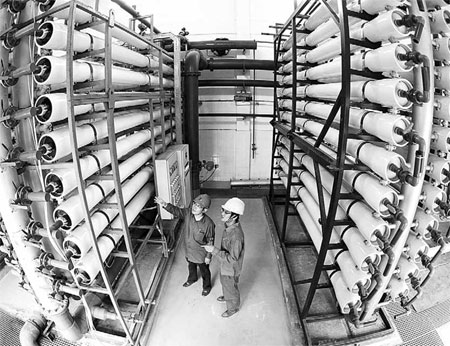Fuel powers economic surge
Updated: 2013-07-24 07:20
By Frank Clemente (China Daily)
|
||||||||
|
China has been taking the lead in mapping out a blueprint for a sustainable future built on coal. Provided to China Daily |
Cleaner technology crucial component of nation's urbanization drive
Clean Coal is the global path out of poverty for the 1.3 billion people who have no electricity whatsoever and another 2.3 billion who have inadequate access to power. China is the prime example of the benefits of increased electricity from coal. The socioeconomic progress of China over the past several decades is the most important societal achievement of our time - and coal is the cornerstone of that growth.
Improvements in health and the standard of living have been so profound that the International Energy Agency has referred to China as a coal-fueled "economic miracle." In fact, 80 percent of the global population taken out of poverty since 1990 is Chinese - all living in a nation which obtains more than 75 percent of its electricity from coal.
Consider a few facts. Since 1990, coal-based electricity in China has increased 650 percent to over 3,500 billion kilowatt hours. During the same period, life expectancy increased by five years, infant mortality declined 60 percent and 600 million more people attained access to an improved water source. Maternal mortality rates dropped 65 percent and female literacy increased 35 percent. Widespread access to electricity has been attained, allowing families to light their homes, refrigerate food and medicine and reduce indoor air pollution through more efficient means of cooking. In the meantime, real GDP per capita increased over seven times and poverty decreased by literally hundreds of millions. China's score on the UN Human Development Index now surpasses the world average.
Declining emissions
Amid these dramatic increases in the quality of life through coal-based generation, relative emissions from power plants have declined steadily. Discharge of particulate matter per unit of electricity has decreased 97 percent over the past three decades. Since 2005, relative emissions of sulfur dioxide have decreased 64 percent. Given the smaller coal units slated to be retired, desulfurization will soon be in place at virtually every coal plant in China. Relative nitrous oxide emissions decreased 8 percent in the past year alone. And reduced mercury emissions are a significant co-benefit of these new controls.
With these technological innovations, coal in the 21st century will perform even better over time. China is already building some of the cleanest power plants in the world along the eastern coast. At Yuhuan, Zhejiang province, for example, China Huaneng Group operates four 1,000 megawatt advanced generating units at a thermal efficiency more than 20 percent better than the global average. Such supercritical and ultra-supercritical facilities produce far more power per unit of fuel than traditional plants - and have far fewer emissions. There are about 430 gigawatts of advanced coal units online or under construction around the world - and more than 175 GW are in China.
Deploying a global fleet of these highly efficient plants would reduce CO2 emissions from coal generation by more than 25 percent and pave the way for carbon capture, utilization and storage. Such technologies could cut global average CO2 emissions from coal plants by as much as 90 percent. The IEA has indicated carbon capture is central to meeting climate policy goals.
Building more centralized advanced coal plants would produce clean electricity and also allow families to burn less oil, charcoal, wood, coal and dung for localized energy. The widespread burning of direct fuels is one of the primary causes of the smog discussed in a recent report on North China in the Proceedings of the US National Academy of Sciences - a study that incidentally contained serious methodological flaws. Nonetheless, clearly moving to clean coal-based electricity is particularly important given the ongoing urbanization of China. By 2030, upwards of 1 billion Chinese will live in cities, taking advantage of stable economic growth and a better quality of life. Access to modern cooking and heating facilities is especially important in an urban environment.
Gregory Boyce, chairman of Peabody Energy Corp, has praised China for taking the lead in formulating a global blueprint for a sustainable energy future built on 21st century coal. This leadership is crucial to the continuing growth and improvement of the human community. Developing nations such as India observe the unprecedented progress of China and see a role model in their midst.
Sustainable coal continues as the world's most rapidly growing fuel for good reason - it is the only energy source that has the scale to simultaneously eradicate poverty, propel economic progress and provide a clean environment. The world's more than 860 billion tons of proved coal reserves are the pathway to a better future for all mankind. President Xi Jinping has called for the creation of "an inexhaustible source of power for boosting common development" for "all people in the world." Coal is the solution.
The author is Professor Emeritus of Social Science, Penn State University and former director of the university's environmental policy center and editor of the IEA report The Global Value of Coal (2012).
(China Daily USA 07/24/2013 page15)
Most Viewed
Editor's Picks

|

|

|

|

|

|
Today's Top News
US diplomat says China ties a priority
Nation falling short on IT security
Weiner not dropping out of NYC mayoral race
Death toll from H1N1 in Argentina reaches 38
DPRK halt on rocket facility confirmed
Celebrations erupt after word of regal delivery
Office to close due to protest in Manila
Multinationals' dependence on China grows
US Weekly

|

|















